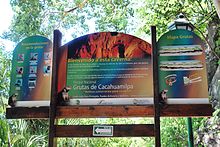Grutas de Cacahuamilpa National Park
The Grutas de Cacahuamilpa National Park is a cave system in Mexico near the city of Taxco that has been declared a national park.
description
The Grutas de Cacahuamilpa is one of the largest active cave systems in the world, which means that it still filters groundwater and the stalactite is still growing. The entrance is an arch over 40 meters wide and 12 meters high. From the entrance, a path leads about 20 meters down into the cave. Inside the cave system are 90 large halls , separated by rock walls, but connected by a central gallery. Only about 20 are fully explored and available to the public. Most of these rooms are located under the Cerro de la Corona limestone ridge . They are on average about 40 meters wide and reach heights of 20 to 81 meters. Most of them have names like the throne room , the cathedral hall or the auditorium . The latter has a large flat floor, has been furnished with seats and is used for events.
history
Parts of the cave system have been known for centuries and were already used in pre-Columbian times . During excavations, fragments were found that prove this. The Grutas area was home to the Olmecs and later that of the Chontal people . Both peoples used the caves for ceremonial purposes. The original name of the caves was Salachi - the current name Cacahuamilpa (peanut field) refers to a place nearby.
After the Spanish conquered Mexico, the existence of the cave was kept secret by the indigenous peoples. The first post-Colombian discoverer of the caves was Manuel Sainz de la Peña Miranda. In 1866 Dominik Bilimek and Maximilian von Habsburg made the first biospelaeological visit to the cave. In 1922, the micropalaeontologist and cave explorer Federico Bonet Marco measured and mapped the cave over a length of 1,380 meters. It was later expanded and made accessible to the public over the years. The first scientific expedition took place in 1935. It was finally declared a national park in 1936 by President Lázaro Cárdenas . The first tours were offered in 1969. In 1987 the development of the cave system was expanded from four to five kilometers.
legend
There is a grave in one hall. The story goes that an Englishman had an accident while exploring and eventually starved to death. He was accompanied by his dog, which he sent out for help. However, nobody outside the cave paid any attention to the dog, so the dog returned to the cave and died with his master. When the remains were found, they were buried under rocks and a simple cross.
See also
Web links and sources
- Official Website (Spanish)
- Website of the Mexican Tourism Association (English)




